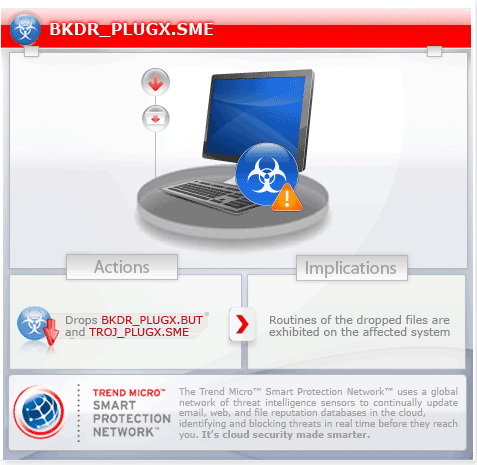BKDR_PLUGX.SME
Backdoor:Win32/Plugx.A (Microsoft); Trojan Horse (Symantec)
Windows 2000, Windows XP, Windows Server 2003


Threat Type: Backdoor
Destructiveness: No
Encrypted:
In the wild: Yes
OVERVIEW
This malware is a remote access tool (RAT) known as PlugX. It is one of the most common malware used in carrying out targeted attacks. The targeted attacks it has been involved in are mostly directed towards government institutions in Japan.
To get a one-glance comprehensive view of the behavior of this Backdoor, refer to the Threat Diagram shown below.

This backdoor arrives on a system as a file dropped by other malware or as a file downloaded unknowingly by users when visiting malicious sites.
It deletes itself after execution.
TECHNICAL DETAILS
Arrival Details
This backdoor arrives on a system as a file dropped by other malware or as a file downloaded unknowingly by users when visiting malicious sites.
Installation
This backdoor creates the following folders:
- %User Profile%\UdpGf
- %User Profile%\SxS
- %All Users Profile%\Gf
- %All Users Profile%\SxS
(Note: %User Profile% is the current user's profile folder, which is usually C:\Windows\Profiles\{user name} on Windows 98 and ME, C:\WINNT\Profiles\{user name} on Windows NT, and C:\Documents and Settings\{user name} on Windows 2000, XP, and Server 2003.)
Other System Modifications
This backdoor adds the following registry keys:
HKEY_LOCAL_MACHINE\Software\CLASSES\
FAST
It adds the following registry entries:
HKEY_LOCAL_MACHINE\SOFTWARE\Classes\
FAST
CLSID = "{random values}"
Dropping Routine
This backdoor drops the following files:
- %User Profile%\UdpGf\NvSmart.usr
- %User Profile%\UdpGf\NvSmart.exe
- %User Profile%\UdpGf\NvSmartMax.dll
- %All Users Profile%\Gf\boot.ldr
- %All Users Profile%\Gf\NvSmart.exe
- %All Users Profile%\Gf\NvSmartMax.dll
(Note: %User Profile% is the current user's profile folder, which is usually C:\Windows\Profiles\{user name} on Windows 98 and ME, C:\WINNT\Profiles\{user name} on Windows NT, and C:\Documents and Settings\{user name} on Windows 2000, XP, and Server 2003.)
Other Details
This backdoor deletes itself after execution.
SOLUTION
Step 1
For Windows XP and Windows Server 2003 users, before doing any scans, please make sure you disable System Restore to allow full scanning of your computer.
Step 2
Delete this registry key
Important: Editing the Windows Registry incorrectly can lead to irreversible system malfunction. Please do this step only if you know how or you can ask assistance from your system administrator. Else, check this Microsoft article first before modifying your computer's registry.
- In HKEY_LOCAL_MACHINE\Software\CLASSES
- FAST
Step 3
Search and delete these folders
- %User Profile%\UdpGf
- %User Profile%\SxS
- %All Users Profile%\Gf
- %All Users Profile%\SxS
Step 4
Scan your computer with your Trend Micro product to delete files detected as BKDR_PLUGX.SME. If the detected files have already been cleaned, deleted, or quarantined by your Trend Micro product, no further step is required. You may opt to simply delete the quarantined files. Please check this Knowledge Base page for more information.
Did this description help? Tell us how we did.


